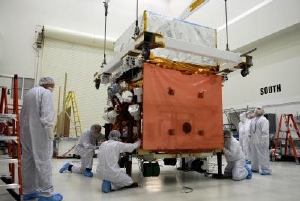Mar 8 2008
NASA's Gamma-ray Large Area Space Telescope, or GLAST, arrived Tuesday at the Astrotech payload processing facility near the Kennedy Space Center to begin final preparations for launch. Liftoff of GLAST aboard a Delta II rocket is currently targeted for 11:45 a.m. EDT on May 16.
 In the Astrotech payload processing facility, General Dynamics technicians watch as GLAST is moved toward a work stand (left) to check GLAST's scientific instruments.
In the Astrotech payload processing facility, General Dynamics technicians watch as GLAST is moved toward a work stand (left) to check GLAST's scientific instruments.
GLAST is a collaborative mission with the U.S. Department of Energy, international partners from France, Germany, Italy, Japan and Sweden, and numerous academic institutions from the U.S. and abroad. The spacecraft will explore the most extreme environments in the universe, and answer questions about supermassive black hole systems, pulsars and the origin of cosmic rays. It also will study the mystery of powerful explosions known as gamma-ray bursts.
The milestones to be accomplished over the next two months include attaching the Ku-band communications antenna and the two sets of solar arrays, a complete checkout of GLAST's scientific instruments, installing the spacecraft's battery, and loading aboard the observatory's propellant. These activities will be performed by General Dynamics, builder of the spacecraft for NASA. GLAST currently is scheduled to be transported to Pad 17-B at Cape Canaveral Air Force Station on May 1.
The rocket that will launch GLAST is a Delta II 7920-H, manufactured and prepared for launch by United Launch Alliance. It is a heavier-lift model of the standard Delta II that uses larger solid rocket boosters. The first stage is scheduled to be erected on Pad 17-B the week of March 17.
The following week, the nine strap-on solid rocket boosters will be raised and attached. The second stage, which burns hypergolic propellants, will be hoisted atop the first stage in late March. Next, the fairing that will surround the spacecraft will be hoisted into the clean room of the mobile service tower.
Engineers will perform several tests of the Delta II. In late April, the first stage will loaded with liquid oxygen and checked for leaks. The following day, a simulated flight test will be performed, testing the vehicle's post-liftoff flight events without fuel aboard. The electrical and mechanical systems of the entire Delta II will be exercised during this test.
Once the GLAST payload is atop the launch vehicle, a final major test will be performed. The combined minus count and plus count test simulates all events as they will occur on launch day, but without propellants aboard the vehicle.
The NASA Launch Services Program at Kennedy Space Center is responsible for the countdown and launch management of the Delta II GLAST mission.